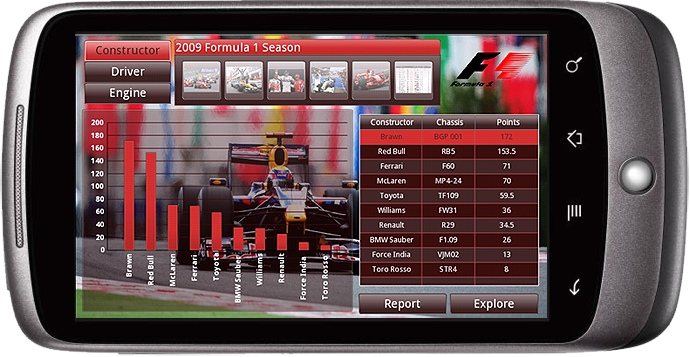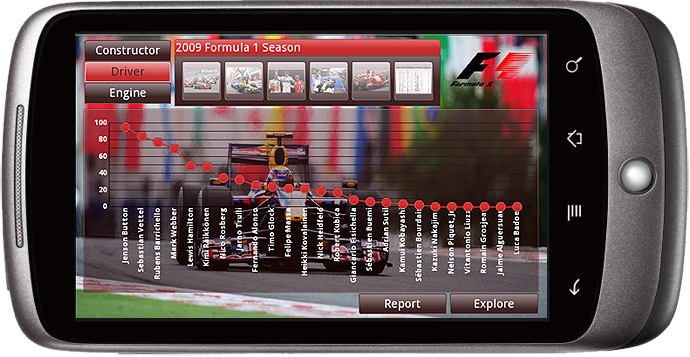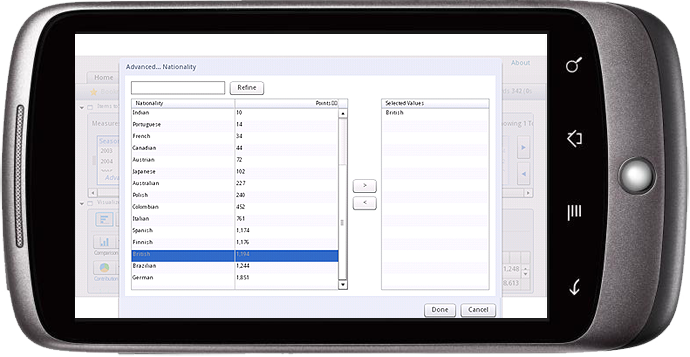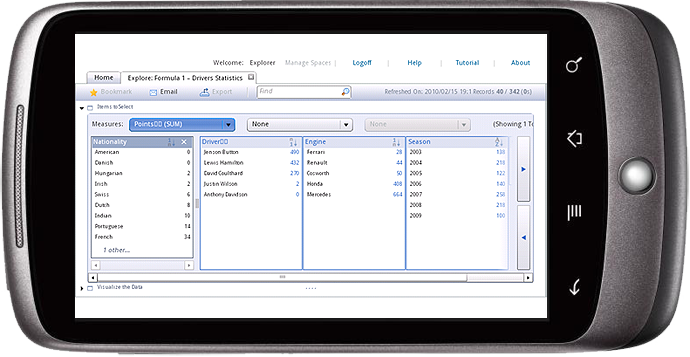Версия для печати
The latest release of Android, v2.2 (“Froyo”) supports the Adobe flash technology used by Xcelsius (now called Dashboard Design) and SAP BusinessObjects Explorer. So now you can access your dashboards, reports, and exploration spaces directly from your mobile device without requiring a separate application (e.g. as you do for the iPhone and iPad).
It also means you can reuse all the effort you’ve put into developing Xcelsius dashboards and make them into slick, use-them-on-the-fly interfaces for your road warriors. Here’s a quick video demonstration of my Google Nexus One phone running Xcelsius, WebIntelligence, and Explorer, based on a Formula One data set (SAP is a sponsor of the Vodaphone McLaren Mercedes racing team, and the McLaren team use SAP’s PLM software).
Here’s a step-by-step picture view of the same demo:
1: open the xcelsius dashboard, using a bookmark link, or typing the dashboard link directly: http://timoelliott.com/blog/docs/formula1_android_open.swf
(Note: the Xcelsius icon below is NOT an application that you have to install, just a shortcut to the URL, which opens in a browser)

The flash file will open up in the browser:

To make it full screen, press and hold your finger on the flash file until the bar below appears

Then click on the left-hand icon to make the flash file full screen:

From here, you can explore the dashboard, for example, press the “Driver” button:

Or the “Engine” button:

You can also “drill through” to information using the other SAP BusinessObjects products. For example, touching the “Report” button can take you directly to a Web Intelligence report (this won’t work with the link above, because it’s a report only available to my account – the link takes you to the generic bi.ondemand.com page, and if you’re previously logged on – you can sign up for a free account – it will take you directly to your data sets, reports, etc.)

This report is rendered in HTML, and full interactable – all drill-downs, etc. will work, and you can use the standard “pinch” gestures to zoom into part of the report, scroll around, etc.:

Click on the “back” arrow on the phone (left-most icon on the bottom row of buttons on the phone) to get back to the previous dashboard (note, I occasionally came across a flash bug here, where the top bar would still appear, throwing off the tracking location of your finger. If this happens, hold your finger until the full screen icon appears, then click below it to get back to full screen)

Next, click on the “Explore button” to open a new pop-up window (you need to have enabled pop-ups in your browser options, or nothing will happen), and it will load an Explorer session with Formula One data (why do this via a pop-up? to make sure that the screen proportions are correct for the next step):
(Note: this data is stored on a corporate SAP server, but you can do the same thing using data you’ve uploaded to your free bi.ondemand.com account)

As before, hold down your finger and make the flash full screen:

This interface requires precision to use, but with a bit of practice, it’s feasible. Here, for example, I click on the pie chart icon to change the chart type:

Next, I click on the “Advanced” section under “Nationality” to get this window, and I chose “British”:

And by clicking on the little arrows to the left of the “Items to Select” section, you can expand it:

Or you can click on the little arrow to the left of “Visualize the data” to expand that part:

A few best-practice tips if you’re interested in recreating a demo like this:
So. There you have it: Xcelsius, Web Intelligence and Explorer all running smoothly on your mobile device, no apps required!
Дэшборды Xcelsius в мобильном телефоне Android
8 июля 2011 Последняя версия Android, v2.2 (“Froyo”) поддерживает технологию Adobe flash, которую использует Xcelsius (который еще называют Dashboard Design) и SAP BusinessObjects Explorer. Таким образом, сегодня Вы получаете доступ к дэшбордам и отчетам непосредственно со своего мобильного устройства, и при этом у Вас нет необходимости в дополнительных приложениях (например, как это происходит при использовании iPhone или iPad).Данная статья является экспертным мнением Тимо Эллиота (ветерана компании SAP и лидера мнения в сфере бизнес-анализа). С ее полной версией Вы можете ознакомиться ниже на языке оригинала (англ.).
Источник: timoelliott.com
Источник: timoelliott.com
Xcelsius Dashboards on Your Android Mobile Phone
The latest release of Android, v2.2 (“Froyo”) supports the Adobe flash technology used by Xcelsius (now called Dashboard Design) and SAP BusinessObjects Explorer. So now you can access your dashboards, reports, and exploration spaces directly from your mobile device without requiring a separate application (e.g. as you do for the iPhone and iPad).
It also means you can reuse all the effort you’ve put into developing Xcelsius dashboards and make them into slick, use-them-on-the-fly interfaces for your road warriors. Here’s a quick video demonstration of my Google Nexus One phone running Xcelsius, WebIntelligence, and Explorer, based on a Formula One data set (SAP is a sponsor of the Vodaphone McLaren Mercedes racing team, and the McLaren team use SAP’s PLM software).
Here’s a step-by-step picture view of the same demo:
1: open the xcelsius dashboard, using a bookmark link, or typing the dashboard link directly: http://timoelliott.com/blog/docs/formula1_android_open.swf
(Note: the Xcelsius icon below is NOT an application that you have to install, just a shortcut to the URL, which opens in a browser)

The flash file will open up in the browser:

To make it full screen, press and hold your finger on the flash file until the bar below appears

Then click on the left-hand icon to make the flash file full screen:

From here, you can explore the dashboard, for example, press the “Driver” button:

Or the “Engine” button:

You can also “drill through” to information using the other SAP BusinessObjects products. For example, touching the “Report” button can take you directly to a Web Intelligence report (this won’t work with the link above, because it’s a report only available to my account – the link takes you to the generic bi.ondemand.com page, and if you’re previously logged on – you can sign up for a free account – it will take you directly to your data sets, reports, etc.)

This report is rendered in HTML, and full interactable – all drill-downs, etc. will work, and you can use the standard “pinch” gestures to zoom into part of the report, scroll around, etc.:

Click on the “back” arrow on the phone (left-most icon on the bottom row of buttons on the phone) to get back to the previous dashboard (note, I occasionally came across a flash bug here, where the top bar would still appear, throwing off the tracking location of your finger. If this happens, hold your finger until the full screen icon appears, then click below it to get back to full screen)

Next, click on the “Explore button” to open a new pop-up window (you need to have enabled pop-ups in your browser options, or nothing will happen), and it will load an Explorer session with Formula One data (why do this via a pop-up? to make sure that the screen proportions are correct for the next step):
(Note: this data is stored on a corporate SAP server, but you can do the same thing using data you’ve uploaded to your free bi.ondemand.com account)

As before, hold down your finger and make the flash full screen:

This interface requires precision to use, but with a bit of practice, it’s feasible. Here, for example, I click on the pie chart icon to change the chart type:

Next, I click on the “Advanced” section under “Nationality” to get this window, and I chose “British”:

And by clicking on the little arrows to the left of the “Items to Select” section, you can expand it:

Or you can click on the little arrow to the left of “Visualize the data” to expand that part:

A few best-practice tips if you’re interested in recreating a demo like this:
- The screen size for the Google Nexus One is 480?800. When I designed the dashboard, I found I had to make the buttons and fonts extra-big in order to make them useable on the phone.
- To get a flash file to show full screen on your Android phone, simply press and hold. A bar will appear with a button to make the flash file full screen.
- Explorer automatically resizes to the available browser size available. Unfortunately, this means that even when you make it full screen, it doesn’t have the right proportions to fill the screen. I got around this by using a popup window set to 480?800, and enabling pop ups in the phone’s browser.
- Obviously, all this will be a lot easier as a new range of Android devices with larger screen sizes become more widely available, such as the French Archos 7 tablet
So. There you have it: Xcelsius, Web Intelligence and Explorer all running smoothly on your mobile device, no apps required!


